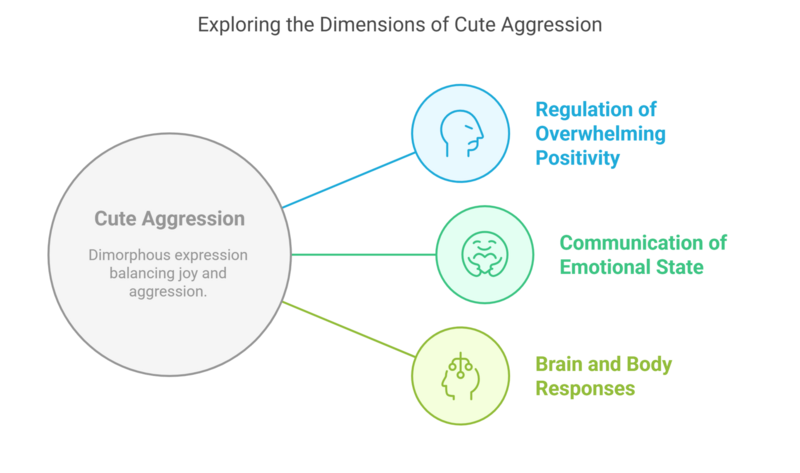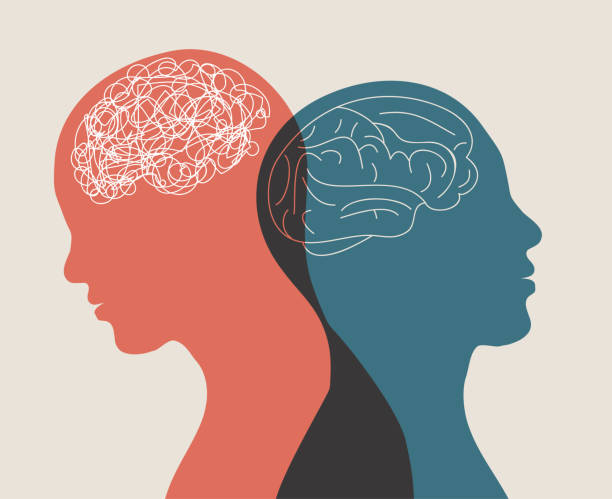Introduction
You see a puppy. Its oversized eyes blink at you. Its tiny paws flop. Suddenly, you feel an urge to pinch, squeeze, or even bite—gently, of course. Why do adorable things provoke an almost violent impulse? This fascinating paradox, called cute aggression, is both universal and mysterious. Understanding it sheds light on how our brains balance overwhelming emotions.

Read More- Anger and Myths Related to it
What Is Cute Aggression?
Cute aggression is a term describing the urge to express aggression in response to something overwhelmingly cute, like exclaiming, “It’s so cute I could just eat it up!” The first formal study of the phenomenon came from Aragón et al. (2015), who demonstrated that people report more aggressive thoughts or facial expressions when viewing extremely cute stimuli.

This paradoxical reaction isn’t just a quirk of language—it’s measurable in brain and physiological responses. It’s thought to help us regulate strong positive emotions, preventing emotional overload (Aragón et al., 2015).
How Widespread Is It?
Cute aggression appears across cultures. In Japanese, “kawaii” culture romanticizes smallness and helplessness; in Filipino, the word “gigil” describes the urge to squeeze something adorable. Studies suggest over 60% of people experience it (Stavropoulos & Alba, 2018).
The Science Behind Cute Overload
1. Baby Schema and Evolution
Konrad Lorenz (1943) introduced the baby schema hypothesis: infantile features like large eyes, round cheeks, and small noses automatically elicit caregiving behaviors in adults. They hack our brains to pay attention and protect.
However, if the emotional reaction is too intense, it can trigger cute aggression as a homeostatic mechanism—basically, a safety valve for too much cuteness (Stavropoulos & Alba, 2018).
2. Brain Areas Involved
Neuroimaging shows that cute aggression activates:
- Reward circuitry (nucleus accumbens, ventral tegmental area)
- Emotional regulation areas (prefrontal cortex)
- Motor planning regions, reflecting urges to touch or squeeze (Stavropoulos & Alba, 2018).
This suggests cute aggression is not about hostility but balancing the desire to nurture with overwhelming emotional arousal.
Aggression Without Malice
Researchers emphasize that cute aggression doesn’t predict violent behavior. Rather, it’s a benign aggression, like when someone says “I could just gobble you up” to a baby.
In fact, people with stronger cute aggression report more empathetic caregiving responses (Aragón et al., 2015).
Psychological Theories of Cute Aggression
1. Affective Balance Theory
Cute aggression helps keep positive emotions in check by introducing a small “dose” of aggression, returning us to emotional equilibrium (Aragón et al., 2015). Without this mechanism, overwhelming joy could impair functioning.
2. Dimorphous Expressions
Cute aggression belongs to dimorphous emotional expressions—emotions expressed with outward signs of their opposite. Another example: crying when extremely happy (Aragón et al., 2015).

Real-World Applications
Understanding cute aggression could improve:
- Marketing: Brands use cuteness to sell everything from cars (e.g., Fiat 500 ads) to snacks. Knowing cute aggression can help predict consumer engagement.
- Pet Adoption Campaigns: Photos of kittens with exaggerated baby-like features drive adoption rates.
- Robotics/AI Design: Designers of social robots use baby schema features to evoke caretaking impulses, as seen in robotic seals used for dementia care (Shibata & Wada, 2011).
When Cuteness Goes Wrong
Though cute aggression itself is harmless, extreme responses can risk animal welfare, such as in “cute pet” tourism where tourists handle stressed animals for selfies.
The Dark Side
The “cuteness industry” sometimes exploits cute aggression, encouraging the breeding of animals with exaggerated features leading to health problems (e.g., brachycephalic dogs like pugs). Our love for cuteness can unintentionally cause suffering.
Cute Aggression Across Ages
- Children: Start showing cute aggression around ages 4–5 (Glocker et al., 2009).
- Adults: Report the strongest reactions.
- Older adults: Experience lower intensity cute aggression, possibly due to reduced reward sensitivity.
Cultural Variations
Cultures with strong “kawaii” traditions (e.g., Japan, South Korea) celebrate cuteness more openly, but studies suggest cute aggression is nearly universal (Nittono, 2016).
Fun Facts About Cute Aggression
- Studies found more cute aggression toward baby animals than adult animals, even if adults are the same size.
- People prone to dimorphous expressions also score higher on measures of emotional empathy.
- Cute aggression can be inhibited by negative moods; people feeling sad or angry are less likely to experience it (Aragón et al., 2015).
Conclusion
Cute aggression is a fascinating, universal human quirk. It shows how our brains regulate powerful positive emotions to maintain balance. Far from a sign of malice, it’s a testament to our deep capacity for care—and a powerful lens for understanding our emotional lives.
References
Aragón, O. R., Clark, M. S., Dyer, R. L., & Bargh, J. A. (2015). Dimorphous expressions of positive emotion: Displays of both care and aggression in response to cute stimuli. Psychological Science, 26(3), 259–273.
Glocker, M. L., Langleben, D. D., Ruparel, K., et al. (2009). Baby schema modulates the brain reward system in nulliparous women. Proceedings of the National Academy of Sciences, 106(22), 9115–9119.
Lorenz, K. (1943). Die angeborenen Formen möglicher Erfahrung. Zeitschrift für Tierpsychologie, 5(2), 235–409.
Nittono, H. (2016). The two-layer model of “kawaii”: A behavioral science framework for understanding cuteness. Frontiers in Psychology, 7, 1500.
Stavropoulos, K. K., & Alba, B. M. (2018). The neuroscience of cute aggression. Frontiers in Behavioral Neuroscience, 12, 300.
Shibata, T., & Wada, K. (2011). Robot therapy: A new approach for mental healthcare of the elderly – A mini-review. Gerontology, 57(4), 378–386.
Subscribe to PsychUniverse
Get the latest updates and insights.
Join 3,030 other subscribers!
Niwlikar, B. A. (2025, July 12). Cute Aggression and 2 Important Scientific Concepts Behind It. PsychUniverse. https://psychuniverse.com/cute-aggression/



